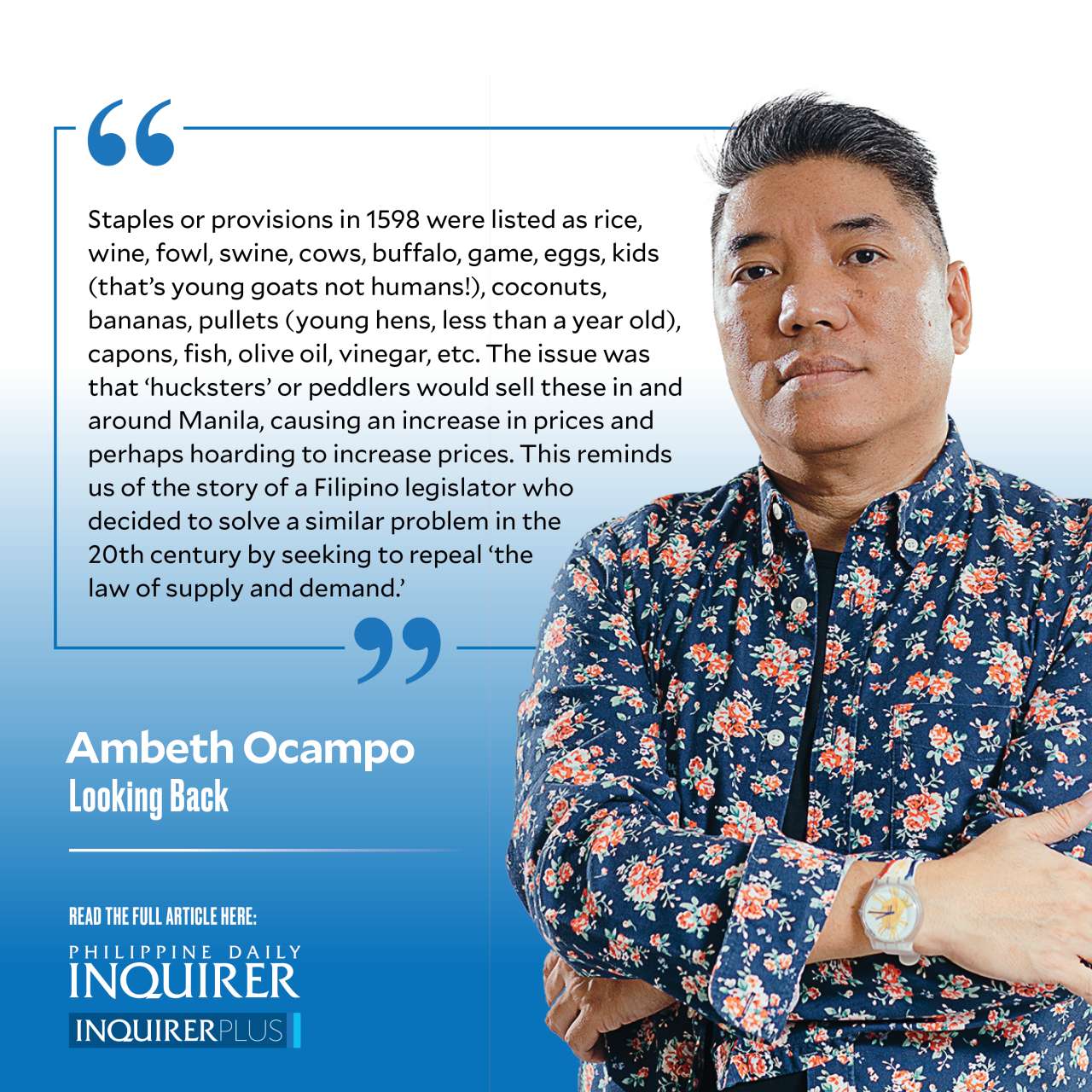Price control in 1598 and 2022

When I wrote my column for Wednesday, the price of onions (red, white, or mixed) was at P380 per kilo, up from P200 weeks earlier. Today, it is P400 per kilo. While seriously considering Sen. Cynthia Villar’s example and learning to live without onions, I reached far back in history and found three decrees from 1598 regulating the sale and prices of food in the distinguished and ever loyal Spanish city of Manila. It was remarkable that the name Antonio de Morga appears in all decrees, because in 1890, Jose Rizal published a profusely annotated edition of Morga’s 1609 book “Sucesos de las islas Filipinas” (Events in the Philippine Islands).
Staples or provisions in 1598 were listed as rice, wine, fowl, swine, cows, buffalo, game, eggs, kids (that’s young goats not humans!), coconuts, bananas, pullets (young hens, less than a year old), capons, fish, olive oil, vinegar, etc. The issue was that “hucksters” or peddlers would sell these in and around Manila, causing an increase in prices and perhaps hoarding to increase prices. This reminds us of the story of a Filipino legislator who decided to solve a similar problem in the 20th century by seeking to repeal “the law of supply and demand.”
In 1598, Morga and the Audiencia of Manila decreed that “no person— Spaniard, Sangley (Chinese), native, or of any other nation, quality and rank whatever—shall trade or barter now and henceforth, in the said provisions or in any of them, in this said city or within the five leagues of its jurisdiction.” Remember that, at the time, Manila was the area within the walls of Intramuros. Reward was offered to informers, and punishment of offenders set at 100 lashes.
Prices of prime commodities: buffalo meat, fowl, swine, hens, chickens, capons, and fish were regulated to address hoarding, high prices, and general suffering. A contract was set with 10 Indian harquebusiers who had hunting permits to bring at least one buffalo to the public slaughterhouse to be weighed and distributed to citizens. City residents, including Chinese gardeners, were ordered to raise fowl and swine under penalty of four reals, a fine turned over to public hospitals. Pork was only to be sold, weighed, in the public square. Pork sold elsewhere was considered hot meat and subject to confiscation. Guilty peddler was punished with 20 lashes. A price was set for fowl that was considered “the principal sustenance of this land.” Nobody could sell above the following: three and a half reals for a Sangley capon, two and a half reals for a laying Sangley hen, two reals for a Moro hen, one and a half reals for a pullet, and one real for a male chicken. Confiscated fowl was divided in three and distributed to the hospitals, the informer, or the judge who enforces the decree. Fish price was also regulated, but not indicated in the decree.
To ensure that Manila was supplied with fowl, swine, and eggs for its sustenance, it was ordered that the neighboring districts of Tondo, Pampanga, Bulacan, Laguna, Mindoro, and Balayan were to punctually send supplies to the capital following this schedule: Tondo was to send such during the first quarter, January to March; Pampanga was in charge of the second quarter, April to June; Bulacan only two months from July to August; Laguna, September to October; with Mindoro and Balayan closing the year at November and December.
The weekly provisions for Manila were set at 300 lying hens, a third or quarter of these being pullets, 2,000 eggs, and a number of swine depending on the production and what was deemed fair and proper. From this schedule, it is clear that Tondo and Pampanga were the most productive areas, but even so, they were not obliged to supply the city the whole year round because they had their own people to feed.
What is the relevance of these late 16th-century ordinances in Manila to us in the 21st century? These show how government, then and now, tries to feed its citizens. It underscores the fact that time and history have marched on, but the situations we find ourselves in remain basically the same. How much did it cost to make a “noche buena” dinner before? Can well-fed government officials tell citizens enduring the brunt of high prices that they should learn to live without prime commodities?
——————
Comments are welcome at aocampo@ateneo.edu




















